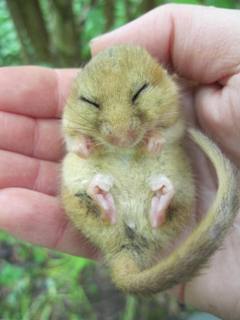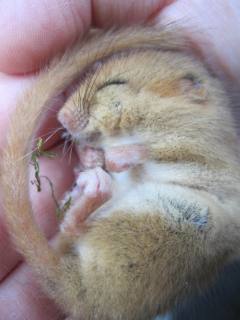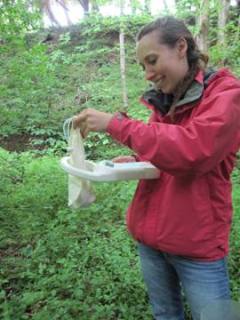News & Events
Latest News
Volunteer Programme April 2019 - September 2019
17.05.2019
Screening For Life Walk 01/07/2015
18.06.2015
Facebook Page
Close Encounters with the Hazel Dormouse
Date: 04.07.2012
Type: Biodiversity
You may have read our news article last November about dormouse surveys we had carried out in Denbighshire. Well, as part of the North Wales Dormouse Project which feeds into the National Dormouse Monitoring Programme, we have again been carrying out dormouse surveys and are delighted to be able share these photographs with you.

 These dormice were found in special dormouse boxes which were put up to aid monitoring of this elusive small mammal. Dormice naturally make nests in holes in old trees or in dense shrub vegetation, but just like hole-nesting birds, they will readily use artificial nest boxes. This means that we can easily monitor dormouse populations by checking the contents of these nest boxes. If we find any dormice inside, they are weighed and sexed and have a hair sample taken for analysis.
These dormice were found in special dormouse boxes which were put up to aid monitoring of this elusive small mammal. Dormice naturally make nests in holes in old trees or in dense shrub vegetation, but just like hole-nesting birds, they will readily use artificial nest boxes. This means that we can easily monitor dormouse populations by checking the contents of these nest boxes. If we find any dormice inside, they are weighed and sexed and have a hair sample taken for analysis.

As the hazel dormouse is a European Protected Species, you need to possess a licence from the Countryside Council for Wales (or equivalent in other parts of the UK) to check dormouse boxes and to handle dormice. Dormice are protected because their numbers have declined due to loss and fragmentation of their woodland habitat, and also changes in woodland management.
Dormice are generally nocturnal and spend almost all their time in trees. They are very adept at climbing with the help of a long tail and sharp claws which are perfect for clinging onto branches. Their diet varies according to the season, including flowers in spring, insects in summer and nuts and berries in autumn. In the winter they go into hibernation at ground level.
The North Wales Dormouse Project is led by North Wales Wildlife Trust. More information can be found on their website. For more information on the National Dormouse Monitoring Programme see the People’s Trust for Endangered Species website.



